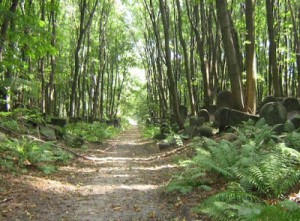
The Warsaw Jewish Cemetery is a forest of its own. (Photo by Rivka Schiller)
I have a certain fascination for cemeteries, and when my friend Rivka Schiller recently shared her journey to Warsaw’s Jewish Cemetery in the fall of 2014 to find her great-great-grandfather’s grave, the headstone of which her family had just had restored, I was stunned by her photos and asked her if she had more. Not only did she have more, but she was willing to put together a photo essay of her visit, plus some of what she discovered jives with the Jewish High Holidays we just celebrated. So I am happy to welcome Rivka to my blog today and take a walk through the Warsaw Jewish Cemetery with her:
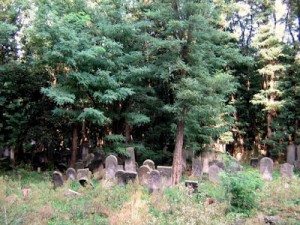
Paying Homage to the Warsaw Jewish Cemetery’s Dead
The Warsaw Jewish Cemetery was established in 1806, occupies some 83 acres, and contains somewhere between 200,000 and 250,000 graves and tombs. It is one of Europe’s largest cemeteries and still in use. Located on the main thoroughfare of Anielewicza Street – named for Mordechai Anielewicz (1919 – 1943), a Jewish leader in the Warsaw Ghetto Uprising who perished when German Forces discovered his bunker – and Okopowa Street, it is easily accessible by bus, tram, and other means of transportation.
Nevertheless, once one steps inside, the surrounding urban landscape practically vanishes from memory.
At least that was my overwhelming feeling while walking amidst the heavily overgrown, densely forested, and greatly crowded graves.
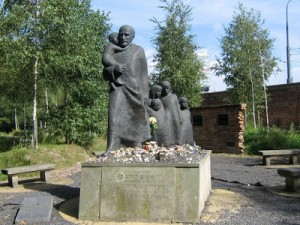
Monument to honor Janusz Korczak (pen name of Henryk Goldszmit), who chose to be deported with the orphans in his care and perished with them in the Treblinka Extermination Camp in 1942.
(Photo by Rivka Schiller)
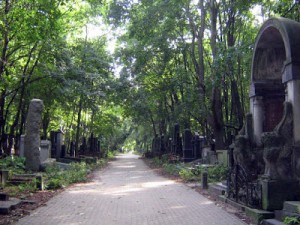
Entrance Path, Warsaw Jewish Cemetery (Photo by Rivka Schiller)
This vast necropolis – already overcrowded prior to the Second World War – had a compelling and transportative effect on me, perhaps because it is one of the relatively few places in Warsaw in which time has stood still.
This cemetery remained more or less untouched during the city’s wartime devastation and its subsequent rebuilding during the communist era; thus bears testimony to what was once the center of World Jewry.
As in other Jewish and non-Jewish cemeteries around the world, some burial sites are quite simple, whereas others are rather ornate and bear artistic stone inscriptions. But the one major feature that sets these headstones apart from those that I have seen in other Jewish cemeteries in the United States and in Israel, is that they often bear both Polish and Yiddish epithets. In some cases, Hebrew is the only language present on the headstones. That was more common among the traditional Jews buried there, people such as my great-great-grandfather:
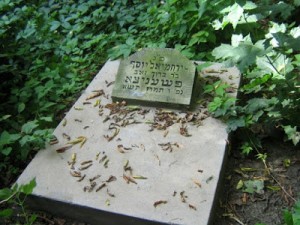
Recently restored headstone and burial site of my great-great-grandfather,
Yerachmiel Yosef Pszenica, who died on July 1, 1941, in the Warsaw ghetto (Photo by Rivka Schiller)
See Rivka’s Yiddish for the story of the headstone
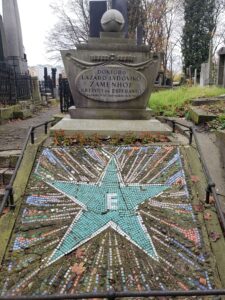
Grave of Ludwik Zamendorf, Warsaw Jewish Cemetery (Photo by Annette Gendler)
The total absence of traditional Jewish languages generally indicates that the deceased party and/or his/her surviving family members was/were fairly acculturated and religiously assimilated.
Indeed, Zamenhof’s youngest daughter, Lidia Zamenhof (1904-1942) went so far as to espouse and preach the Bahá’í faith, even stating shortly before her death in the Treblinka Extermination Camp: “I am a Bahá’í and will die a Bahá’í.”
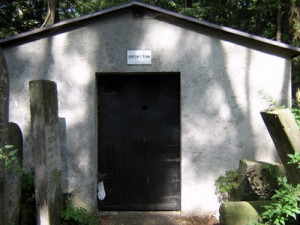
Ohel of the Radzyminer Rebbe, Warsaw Jewish Cemetery (Photo by Rivka Schiller)
The Warsaw Jewish Cemetery also bears witness to the great Jewish cultural life of pre-WWII Warsaw.
One of the most elegant and feminine-looking headstones that I came across was that of Esther Rokhl Kamińska, the “mother of Yiddish theater.” Today, the Polish State Yiddish Theater of Warsaw – in Polish, the Teatr Żydowski im. Estery Racheli i Idy Kamińskich, bears the names of this talented woman and her perhaps equally talented daughter Ida Kamińska.
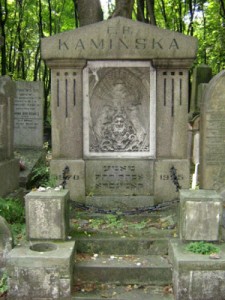
Ornate grave of Esther Rokhl Kamińska, the “mother of the Yiddish theater.”
(Photo by Rivka Schiller)
Earlier in 1943, Klepfisz had managed to smuggle out his wife, Rose, and daughter, Irena, from the ghetto. The two survived World War II. Irena went on to publish a great deal of poetry, some of which makes explicit reference to her father’s heroic death and the fact that she will never know where his remains truly lie, given the brutal nature of his death.
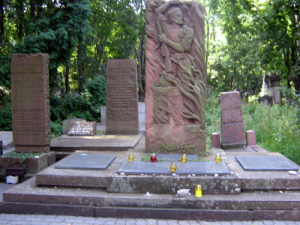
Monument for members of the Bund who died in battle during the WWII.
In the forefront to the extreme left is the cenotaph of Bund member Michał Klepfisz, who died in the Warsaw Ghetto Uprising of 1943. (Photo by Rivka Schiller)
Having already read about Michał Klepfisz in his daughter’s poetry and elsewhere, I was fully aware that the stone that serves as Klepfisz’s grave marker. However, it is not his true eternal resting place, but rather a cenotaph, i.e., “a tomb or a monument erected in honor of a person or group of persons whose remains are elsewhere” (according to Merriam-Webster).
Finally, the most recent – and perhaps most unusual – of the headstones I am sharing here is from 1971 and belongs to the late Szmul Tencer (1915-1971). It features a highly aesthetic sculpture of a hand and part of what appears to be a sleeve, jacket, or suit cuff. Although difficult to make out here, the triangular cuff is engraved with a lengthy inscription in Hebrew characters.

Sculpture adorning the grave of Szmul Tencer, Warsaw Jewish Cemetery (Photo by Rivka Schiller)
As I recently learned, the oversized and downturned hand rests upon a book, which is meant to be none other than the “Book of Life” – known in Hebrew as the “Sefer Chaim.”
This is the same book that is discussed in the Jewish tradition within the context of the recently observed Jewish New Year (Rosh Hashanah) and Day of Atonement (Yom Kippur). It is said that on Yom Kippur, God decides who shall live and who shall die in the coming year, thereby sealing the given person’s “Book of Life.” Hence, the hand depicted in this funerary sculpture, created by the Polish sculptor Ryszard Wojciechowski (1939-2003), is most likely meant to represent the symbolic hand of God, who has decided that the time has come for the ultimate sealing of Szmul Tencer’s “Book of Life.”
Thus ends my photo essay of my wanderings through the Warsaw Jewish Cemetery. Thanks for coming along and please feel free to share your comments below and visit me at Rivka’s Yiddish.
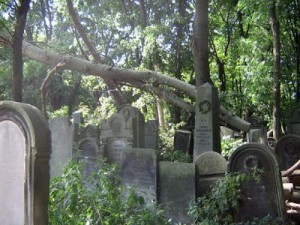
Warsaw Jewish Cemetery (Photo by Rivka Schiller)

Poignant and peaceful. Beautiful shots!
Thank you very much, William, for your lovely remarks! I did not have in mind that I would be making these photos public at the time when I took them, but Annette was very encouraging and eager to see some of my many photos from my 2014 journey to Poland. I am glad that I was ultimately able to locate the grave of my great great grandfather and to pay homage to him, as well as to the numerous other individuals who are buried in the Warsaw Jewish Cemetery.
Really nice piece, thank you.
Trevor, thank you very much for your nice remarks. I look forward to being in touch with you re: your work and travels!
Thank you for sharing this with us.
Nancy, I very much appreciate your taking the time to read this — thank you!
Thanks so much to Annette, for encouraging me to write this piece and for generously agreeing to feature it on her wonderful website!
With much gratitude,
Rivka
I'm so glad you shared and took us along on this visit!